|
TennisOne Lessons
by Dave Smith
OverviewCurrently, you can count on one hand the players on the pro tour hitting a two-handed forehand. Many believe that Monica Seles, Jan-Michael Gambill and Fabrice Santoro are anomalies, rare instances of players using abnormal strokes who have made an impact on the tour. Is this merely a variance from convention, or could the two-handed forehand evolve into a “revolutionary” new stroke? I can hear the whispers of heresy and “no way, Jose'” being echoed among the tennis populous! Before we completely discount the two-handed forehand, let's not forget that the two-handed backhand took time to make its mark upon the tennis scene and met with considerable resistance as well. Remarkably, tennis experienced nearly 100 years of competitive play before a significant two-handed backhand appeared. You would be hard pressed to name any two-handed backhand players—male or female—prior to 1971.
Until Jimmy Connors, Bjorn Borg, and Chris Evert emerged in the early 70's, the two-handed backhand was considered remarkably unconventional. Ironically, even as these players dominated tennis for years, it would take another 20 years before the two-handed backhand would be considered commonplace. Consider too, that today we have nearly 70 percent of the top men using the stroke and well over 90 percent of the women. That's quite a transformation!
Is the two-handed forehand on a similar path toward player acceptance, the same path the two-handed backhand experienced over the last thirty years? I doubt it…at least not in the same magnitude. Because of the still favorable advantages most players enjoy using the one-handed forehand, I don't believe a two-handed version will make as big an impact. However, if one observes the vast number of young players now climbing high among the junior rankings who are executing potent two-handed forehands, a significant increase of high-performing two-handed forehand players is sure to come. In addition, my study of the stroke over the past fifteen years has shown that the two-handed forehand provides an incredible foundation for anyone wanting to learn to hit the one-handed forehand. HistoryWhile its notoriety has been far overshadowed by the sheer number of one-handed forehand players, the inarguable success of the two-handed forehand—among those who have mastered the stroke—has made a significant mark in tennis history. It was back in 1943 that Francisco “Pancho” Segura, an Ecuadorian, would introduce the significant potential of a two-handed forehand. Segura reached a ranking of number 4 in the U.S. and won 14 North American tournament titles using the two-hander.
Also in the 1940's there emerged a lesser-known doubles great, John Edward Bromwich, an Australian who was an ambidextrous player using a two-handed stroke on his right side. However unknown, Bromwich managed to win two Australian singles titles and 13 other Grand Slam doubles titles, including 3 U.S. Titles, two Wimbledon, and 5 mixed doubles titles. Gene Mayer first introduced the two-handed forehand to the modern pro game. Mayer a New Yorker, used a most unorthodox, two-handed stroke on both sides—placing his dominant hand above the other hand for both his forehand and backhand. Though Mayer reached number 4 in the world in 1980 as well as a number 2 world ranking in doubles, it would be another ten years before another world-class player would emerge using the stroke.
Because very few teaching pros hit or know how to teach the two-handed forehand, the proliferation of the stroke has been slow. (We can recognize similar circumstances when the two-handed backhand was first emerging.) When Monica Seles proved the stroke could be taken to the highest level on tour, (Number one in the world), players began to see its potential. However, at the same time, many players and teaching pros branded Seles' stroke as an isolated instance of success or a simple case of extremely rare achievement. (Incidentally, this was the initial critical response of Borg and Connor's two-handed backhands as well!) Many pros simply refuse to study the stroke assuming that few players would benefit from such technique. Yet, since relatively few players have been introduced to the stroke, it would be hard to draw an empirical conclusion from such a small experimental field! Even from such a small offering, many have excelled using the stroke. TechniquesThere is one main dissimilarity when comparing the two-handed forehand to the two-handed backhand. This is the variety of technical methods used by the two-handed forehand players mentioned earlier. While virtually all two-handed backhand players use the same grip position (dominant hand on bottom), there are three distinctive two-handed forehand methods. With all three methods, the stroke is effective and consistent. However, they all offer a variety of advantages and disadvantages compared to the conventional forehand and to each other. Three Working Models
Next month, I will describe the main stroke components of this third method and offer several of the learning advantages I have found through the study and teaching of this stroke. |
|||||||||||||||

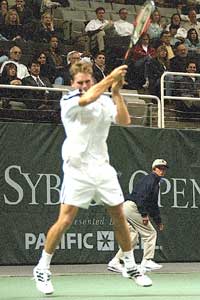

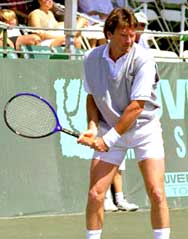
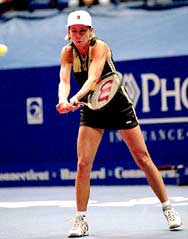
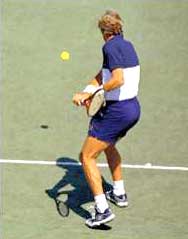
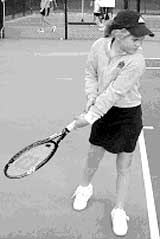
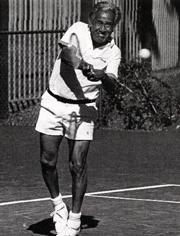
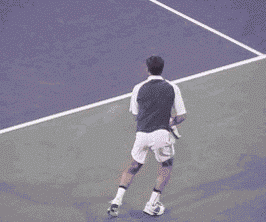
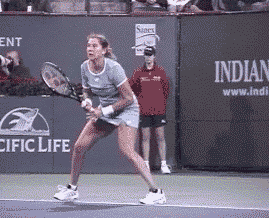
 Your comments are welcome. Let us know what you think about this article by
Your comments are welcome. Let us know what you think about this article by